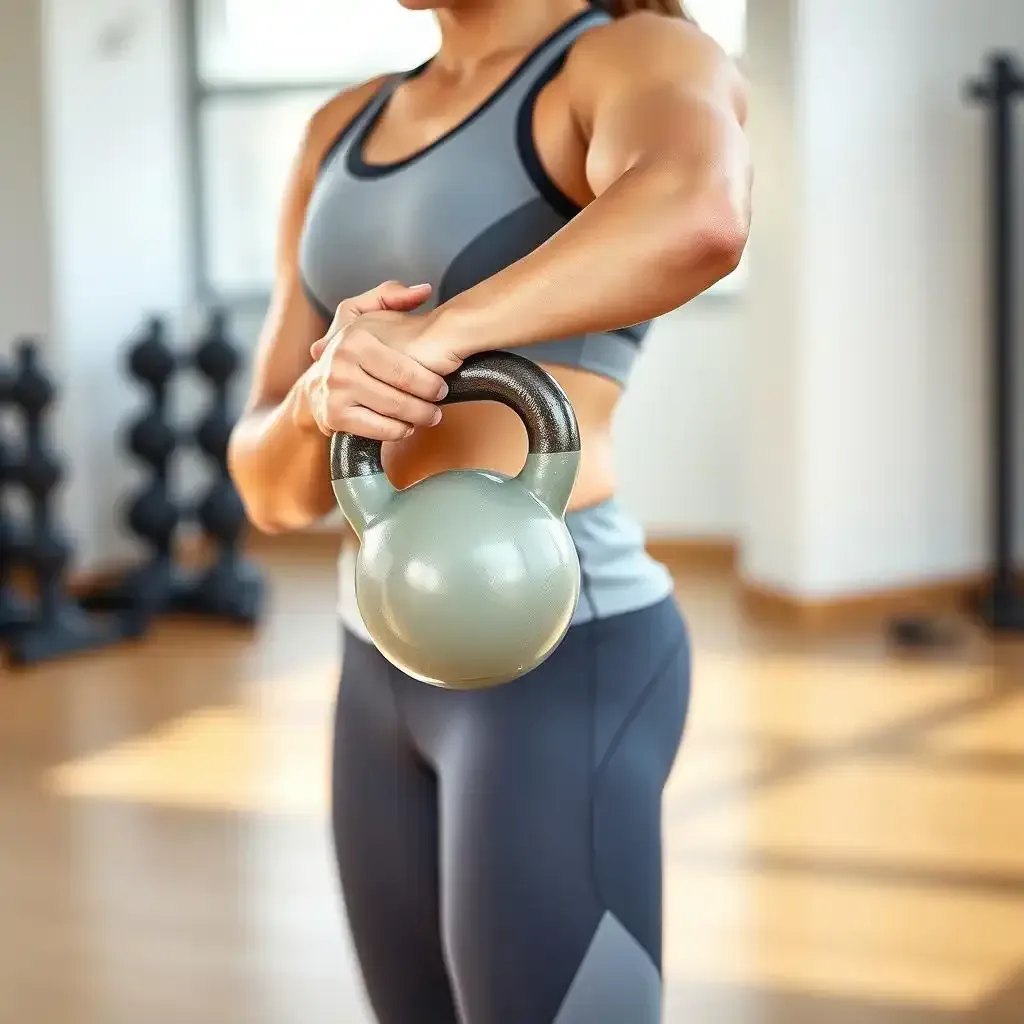Table of Contents
Ever felt that killer muscle soreness after a kettlebell workout? We've all been there. But what if I told you that you could actually *enhance* your fitness process by strategically combining kettlebell training with smart recovery techniques? This isn't about endless rest days; it's about optimizing your time and energy for maximum results. This article, brought to you by kettlebellworkout.homes, will explore the synergistic relationship between intense kettlebell sessions and targeted recovery methods. We’ll cover everything from active recovery strategies that keep you moving (and improving!) between workouts to injury prevention and rehabilitation using specific recovery tools. Get ready to find how to make the most of your kettlebell training, minimizing downtime and maximizing your gains. We'll explore how incorporating recovery tools alongside your kettlebell workouts can improve your progress, helping you build strength, endurance, and resilience more effectively. Ready to level up your fitness game? Let's explore in!
Why Kettlebells Are Your Best Workout Buddy

Why Kettlebells Are Your Best Workout Buddy
Total Body Transformation
Hey there, fellow fitness enthusiast! Let's talk kettlebells. I've been using them for years, and honestly, they're a game-changer. Forget those boring, isolating exercises. Kettlebells are all about functional fitness—movements you actually use in daily life. Think about lifting groceries, playing with your kids, even just getting up from a chair. Kettlebells help you build strength and endurance in ways that translate to real-world ability. They're incredibly versatile; you can do tons of different exercises, from swings and snatches to squats and presses. It's like having a whole gym in one piece of equipment! One day you might be working on explosive capability with some heavy swings, the next day you're focusing on building core strength with Turkish get-ups. It keeps things interesting, which is key to sticking with any workout routine.
Seriously, it’s not just me saying this. Kettlebell training has been scientifically shown to improve cardiovascular health, boost metabolism, and even increase bone density. Plus, the variety of exercises keeps your body guessing, preventing plateaus. Want a killer full-body workout in 20 minutes? Kettlebells are your answer. You don't need a fancy gym or a ton of equipment – just a kettlebell (or two!), and you're good to go. Need some ideas to get you started? Check out our beginner kettlebell routines here for some super simple exercises.
Exercise | Muscle Groups Worked | Benefits |
|---|---|---|
Kettlebell Swings | Glutes, Hamstrings, Core | Capability, Endurance, Core Strength |
Goblet Squats | Quads, Glutes, Hamstrings, Core | Strength, Balance, Leg Ability |
Kettlebell Presses | Shoulders, Triceps, Chest | Upper Body Strength, Stability |
Beyond the Burn: Kettlebells for a Stronger You
But here’s the thing that really sets kettlebells apart: it's not just about the workout itself, it's about the way it makes you feel. I find that kettlebell training builds a kind of resilience. You know, that feeling where you can handle whatever life throws at you, both physically and mentally? That's what I get from it. There's something incredibly empowering about mastering a challenging kettlebell exercise. It’s not just about getting bigger muscles; it's about feeling stronger, more coordinated, and more confident in your own body. Plus, it's a great way to relieve stress. Nothing beats a good sweat session to clear your head!
And let’s not forget the community aspect! Finding a kettlebell class or even connecting with other enthusiasts online can really boost your motivation. It's amazing how much support and encouragement you can get from others who understand the challenges and rewards of kettlebell training. Want to learn more about building a solid foundation with kettlebells? Our guide to kettlebell basics is a great place to start. Kettlebell Basics It's all about finding the right weight for you and learning proper form to avoid injury. Remember, consistency is key—even short, regular workouts are more effective than infrequent intense ones. Think of it as a marathon, not a sprint!
- Improved Cardiovascular Health
- Increased Metabolism
- Enhanced Core Strength
- Improved Bone Density
- Increased Functional Strength
Kettlebell with Recovery Tools: The Graphite Coregeous Ball
Massaging Your Way to Better Recovery
I’m a big fan of the Graphite Coregeous Ball. This little gem is an inflatable air-filled sponge ball that can work wonders for your recovery. After a grueling kettlebell session, your muscles can feel pretty tight and sore. The Coregeous Ball helps by massaging and activating your core muscles, which can speed up the recovery process. It’s like having a mini-massage therapist right in your living room!
Think of it this way: after a tough workout, your muscles are like tangled spaghetti. The Coregeous Ball helps untangle those muscles by applying gentle pressure and massage. This not only feels great but also helps to improve blood flow, which is crucial for recovery. Just a few minutes of using the Coregeous Ball can make a big difference. Check out our for more tips!
Benefit | Explanation |
|---|---|
Muscle Relaxation | Helps release tension in core muscles. |
Improved Blood Flow | Enhances circulation, aiding in faster recovery. |
Pain Relief | Reduces soreness and discomfort post-workout. |
Activating the Core: It’s Not Just About Looking Good
One of the best things about the Coregeous Ball is its ability to activate your core muscles. Your core is more than just your abs; it includes your back, hips, and even your pelvic floor. A strong core is crucial for overall stability and balance, which can make a huge difference in your kettlebell workouts. For example, if your core is weak, you might find it harder to maintain proper form during kettlebell swings or goblet squats.
Using the Coregeous Ball isn’t just about feeling good; it’s about enhancing your performance. By regularly using this tool, you can build a stronger, more resilient core. This means you’ll be able to lift heavier weights, perform more complex movements, and reduce the risk of injury. Plus, a strong core can improve your overall posture, which is a bonus for anyone who spends a lot of time sitting at a desk. If you want to learn more about core strength, check out our page.
- Enhances core strength
- Improves stability and balance
- Reduces the risk of injury
- Improves posture
Active Recovery with Kettlebells

Active Recovery With Kettlebells
Okay, so you just crushed a killer kettlebell workout. You're feeling the burn, maybe even a little wobbly. Don't just collapse on the couch! Active recovery is where it's at. Think of it like this: your muscles are like a high-performance engine that's just been pushed to its limits. You wouldn't just shut it off cold, would you? You'd let it cool down gradually. Active recovery is that gradual cool-down for your muscles.
Instead of total rest, we're talking about light, low-impact activities that keep your blood flowing and help your muscles recover faster. I’m not talking about another intense workout; think gentle movements. A brisk walk, some light cycling, or even some simple bodyweight exercises like arm circles or leg swings can do wonders. It's about keeping things moving, not pushing yourself to the point of exhaustion again. This is where kettlebells can be your secret weapon. You can use lighter kettlebells for some very easy exercises.
- Light Kettlebell Swings (with a lighter weight)
- Gentle Goblet Squats (fewer reps)
- Arm and Leg Circles
For example, after a heavy kettlebell session focusing on swings and snatches, I might follow up with a series of light kettlebell Turkish get-ups. These engage your core and improve mobility without putting excessive stress on your already tired muscles. It's a way to keep your muscles active and your blood flowing without adding to muscle soreness. Remember, proper form is always crucial, even during active recovery. Check out our guide if you need a refresher.
Another great active recovery strategy is to incorporate some stretching. This improves flexibility and range of motion, reducing the chance of muscle stiffness and injury. Think of it as untangling those knots in your muscles after a good workout. You can use your kettlebell to help with this, too! For example, holding a lighter kettlebell while performing static stretches can help you deepen your stretches and improve your flexibility even more. Want to learn more about stretching techniques? Check out our guide to kettlebell stretching for more tips.
Active Recovery Exercise | Benefits | How-to |
|---|---|---|
Light Kettlebell Carries | Improved circulation, core engagement | Hold kettlebell close to your body and walk slowly. |
Kettlebell Rotations | Increased mobility, improved posture | Gently rotate your torso while holding a light kettlebell. |
Static Stretching with Kettlebell | Increased flexibility, reduced muscle soreness | Hold a light kettlebell to deepen your stretches. |
Kettlebell with Recovery Tools: Injury Prevention and Recovery

Kettlebell With Recovery Tools Injury Prevention And Recovery
I've seen it time and time again - someone gets excited about a new kettlebell routine, dives in headfirst, and then boom, they're sidelined by an injury. It's frustrating, especially when it's preventable. Injuries are a part of the game, but by incorporating recovery tools into your routine, you can reduce your risk and bounce back faster.
Think of your body like a high-performance car. You put in the best fuel, you change the oil regularly, and you take it in for tune-ups to keep it running smoothly. Recovery tools are like the pit crew for your body. They help you repair and maintain your muscles, joints, and mind, so you can keep pushing yourself to new heights.
Recovery Tool | Benefits | How to Use |
|---|---|---|
Foam Roller | Reduces muscle soreness, improves circulation | Roll out your muscles before and after a workout |
lb Kettlebell | Strengthens grip, improves forearm endurance | Use it for grip strengthening exercises |
Weighted Vest | Increases strength, endurance, and agility | Wear it while doing kettlebell exercises |
If you're new to kettlebell training, start with lighter weights and progress gradually. Warm up before each workout, and cool down afterwards to prevent muscle strain. Want to learn more about kettlebell basics? Check out our for a comprehensive overview.
One of the best ways to prevent injury is to listen to your body. If you're feeling tired or sore, take a rest day or modify your workout. Don't push yourself too hard, especially if you're just starting out. It's better to err on the side of caution and recover slowly than to risk a serious injury.
- Listen to your body
- Warm up and cool down
- Start with lighter weights
- Progress gradually
Some of the best recovery tools for kettlebell training include foam rollers, weighted vests, and grip strengtheners. These tools can help reduce muscle soreness, improve circulation, and increase strength and endurance.
Final Thought
Integrating recovery tools into your kettlebell routine isn't just about avoiding injury; it's about optimizing your performance and achieving your fitness goals faster. By understanding the importance of active recovery, utilizing specific tools to target muscle groups, and prioritizing injury prevention, you can transform your training from a grueling cycle of push and pain into a sustainable and rewarding process of strength and resilience. Remember, consistency and smart recovery are key to long-term success. So, grab your kettlebells, your recovery tools, and get ready to reveal your full potential!